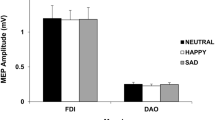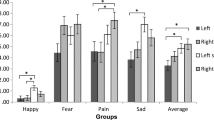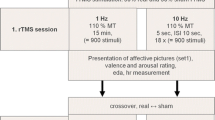Abstract
Recognition of emotional facial expressions is based on simulation and mirroring processes, and the premotor cortex is supposed to support this simulation mechanism. The role of this prefrontal area in processing emotional faces with different valence (anger, fear, happiness and neutral) was explored taking into account the effect of the lateralization model (more right-side activation for negative emotions; more left-side activation for positive emotions) of face processing and anxiety level (high vs low). High-frequency repetitive transcranial magnetic stimulation (rTMS, 10 Hz) was applied to the left prefrontal area to induce an increased activation response within the left premotor cortex. Twenty-nine subjects, who were divided into two different groups depending on their anxiety level (high/low anxiety; State-Trait-Anxiety Inventory (STAI), were asked to detect emotion / no emotion. Accuracy (AcI) and response times (RTs) were considered in response to the experimental conditions. A general significant increased performance was found in response to positive emotions in the case of left-side stimulation. Moreover, whereas high-anxiety subjects revealed a significant negative-valence bias in absence of stimulation, they showed a more significant AcI increasing and RTs decreasing in response to positive emotions in case of left premotor brain activation. The present results highlight the role of the premotor system for facial expression processing as a function of emotional type, supporting the existence of a valence-specific lateralized system within the prefrontal area. Finally, a sort of “restoring effect” induced by TMS was suggested for high-anxiety subjects.
Similar content being viewed by others
References
Adolphs R., Neural systems for recognizing emotion, Curr. Opin. Neurobiol., 2002, 12, 169–177
Balconi M., Bortolotti A., Conscious and unconscious face recognition is improved by high-frequency rTMS on pre-motor cortex, Conscious. Cogn., 2013, 22, 771–778
Goldman A.I., Sripada C.S., Simulationist models of face-based emotion recognition, Cognition, 2005, 94, 193–213
Van Der Gaag C., Minderaa R.B., Keysers C., Facial expressions: what the mirror neuron system can and cannot tell us, Soc. Neurosci., 2007, 2, 179–222
Balconi M., Bortolotti A., Self-report, personality and autonomic system modulation in response to empathic conflictual versus non conflictual situation, Cogn. Emot., 2013, 28, 153–162
Chakrabarti B., Bullmore E., Baron-Cohen S., Empathizing with basic emotions: common and discrete neural substrates, Soc. Neurosci., 2006, 1, 364–384
Hussey E., Safford A., Perception of facial expression in somatosensory cortex supports simulationist models, J. Neurosci., 2009, 29, 301–302
Balconi M., Bortolotti A., Detection of the facial expression of emotion and self-report measures in empathic situations are influenced by sensorimotor circuit inhibition by low-frequency, Brain Stimul., 2012, 5, 330–336
Pitcher D., Garrido L., Walsh V., Duchaine B.C., Transcranial magnetic stimulation disrupts the perception and embodiment of facial expressions, J. Neurosci., 2008, 28, 8929–8933
Balconi M., Canavesio Y., High-frequency rTMS improves the facial mimicry and detection responses in an empathic emotional task, Neuroscience, 2013, 236, 12–20
Balconi M., Ferrari C., rTMS stimulation on left DLPFC increases the correct recognition of memories for emotional target and distractor words, Cogn. Affect. Behav. Neurosci., 2012, 12, 589–598
Baeken C., De Raedt R., van Schuerbeek P., Vanderhasselt M.A., De Mey J., Bossuyt A., et al., Right prefrontal HF-rTMS attenuates right amygdala processing of negatively valenced emotional stimuli in healthy females, Behav. Brain Res., 2010, 214, 450–455
Baeken C., Van Schuerbeek P., De Raedt R., De Mey J., Vanderhasselt M.A., Bossuyt A., et al., The effect of one left-sided dorsolateral prefrontal cortical HF-rTMS session on emotional brain processes in women, Psychiatr. Danub., 2010, 22(Suppl. 1), S163
De Raedt R., Leyman L., Baeken C., Van Schuerbeek P., Luypaert R., Vanderhasselt M.A., et al., Neurocognitive effects of HF-rTMS over the dorsolateral prefrontal cortex on the attentional processing of emotional information in healthy women: an event-related fMRI study, Biol. Psychol., 2010, 85, 487–495
Balconi M., Bortolotti A., The “simulation” of the facial expression of emotions in case of short and long stimulus duration. The effect of pre-motor cortex inhibition by rTMS, Brain Cogn., 2013, 83, 114–120
Balconi M., Brambilla E., Falbo L., Appetitive vs. defensive responses to emotional cues. Autonomic measures and brain oscillation modulation, Brain Res., 2009, 1296, 72–84
Davidson R., Irwin W., The functional neuroanatomy of emotion and affective style, Trends Cogn. Sci., 1999, 3, 11–21
Balconi M., Mazza G., Lateralisation effect in comprehension of emotional facial expression: a comparison between EEG alpha band power and behavioural inhibition (BIS) and activation (BAS) systems, Laterality, 2010, 15, 361–384
Balconi M., Ferrari C., rTMS stimulation on left DLPFC affects emotional cue retrieval as a function of anxiety level and gender, Depress. Anxiety, 2012, 29, 976–982
Balconi M., Ferrari C., Repeated transcranial magnetic stimulation on dorsolateral prefrontal cortex improves performance in emotional memory retrieval as a function of level of anxiety and stimulus valence, Psychiatry Clin. Neurosci., 2013, 67, 210–218
Fox E., Processing emotional facial expressions: the role of anxiety and awareness, Cogn. Affect. Behav. Neurosci., 2002, 2, 52–63
Bishop S., Duncan J., Brett M., Lawrence A.D., Prefrontal cortical function and anxiety: controlling attention to threat-related stimuli, Nat. Neurosci., 2004, 7, 184–192
Mathews A., Mackintosh B., A cognitive model of selective processing in anxiety, Cogn. Ther. Res., 1998, 22, 539–560
Zwanzger P., Fallgatter A.J, Zavorotnyy M., Padberg F., Anxiolitic effect of transcranial magnetic stimulation-an alternative treatment option in anxiety disorders?, J. Neural Transm., 2009, 116, 767–775
Schutter D., van Honk J., d’Alfonso A.A., Postma A., de Haan E.H., Effects of slow rTMS at the right dorsolateral prefrontal cortex on EEG asymmetry and mood, Neuroreport, 2001, 12, 445–447
van Honk J., Schutter D.J., d’Alfonso A.A., Kessels R.P., de Haan E.H., 1 Hz rTMS over the right prefrontal cortex reduces vigilant attention to unmasked but not to masked fearful faces, Biol. Psychiatry, 2002, 52, 312–317
Oldfield R.C., The assessment and analysis of handedness: the Edinburgh inventory, Neuropsychologia, 1971, 9, 97–113
Beck A.T., Steer R.A., Brown G.K., Manual for the Beck Depression Inventory — II, Psychological Corporation, San Antonio, TX, USA, 1996
Spielberger C.D., Gorsuch R.L., Lushene R.E., Manual for the state-trait anxiety inventory, Consulting Psychologist Press, Palo Alto, CA, USA, 1970
Ekman P., Friesen W.V., Pictures of facial affect, Consulting Psychologist Press, Palo Alto, CA, USA, 1976
Harmer C.J., Thilo K.V., Rothwell J.C., Goodwin G.M., Transcranial magnetic stimulation of medial-frontal cortex impairs the processing of angry facial expressions, Nat. Neurosci., 2001, 4, 17–18
Balconi M., Ferrari C., Left DLPFC rTMS stimulation reduced the anxiety bias effect or how to restore the positive memory processing in high-anxiety subjects, Psychiatry Res., 2013, 209, 554–559
Eysenck M.W., Payne S., Derakshan N., Trait anxiety, visuospatial processing, and working memory, Cogn. Emot., 2005, 19, 1214–1228
Miniussi C., Ruzzoli M., Walsh V., The mechanism of transcranial magnetic stimulation in cognition, Cortex, 2010, 46, 128–130
Rossi S., Hallett M., Rossini P.M., Pascual-Leone A., Safety, ethical considerations, and application guidelines for the use of transcranial magnetic stimulation in clinical practice and research, Clin. Neurophysiol., 2008, 120, 2008–2039
Pourtois G., Sander D., Andres M., Dissociable roles of the human somatosensory and superior temporal cortices for processing social face signals, Eur. J. Neurosci., 2004, 20, 3507–3515
Mogg V., Bradley B.P., A cognitive-motivational analysis of anxiety, Behav. Res. Ther., 1998, 36, 809–848
Egloff B., Hock M., Interactive effects of state anxiety and trait anxiety on emotional Stroop interference, Pers. Indiv. Differ., 2001, 31, 875–882
Amir N., Weber G., Beard C., Bomyea J., Taylor C.T., The effect of a single-session attention modification program on response to a public-speaking challenge in socially anxious individuals, J. Abnorm. Psychol., 2008, 117, 860–868
Heeren A., Reese H.E., McNally R.J., Philippot P., Attention training toward and away from threat in social phobia: effects on subjective, behavioral, and physiological measures of anxiety, Behav. Res. Ther., 2012, 50, 30–39
d’Alfonso A.A., van Honk J., Hermans E., Postma A., de Haan E.H., Laterality effects in selective attention to threat after repetitive transcranial magnetic stimulation at the prefrontal cortex in female subjects, Neurosci. Lett., 2000, 280, 195–198
Author information
Authors and Affiliations
Corresponding author
About this article
Cite this article
Balconi, M., Canavesio, Y. & Finocchiaro, R. Transcranial magnetic stimulation modulates left premotor cortex activity in facial expression recognition as a function of anxiety level. Translat.Neurosci. 5, 165–172 (2014). https://doi.org/10.2478/s13380-014-0226-6
Received:
Accepted:
Published:
Issue Date:
DOI: https://doi.org/10.2478/s13380-014-0226-6




